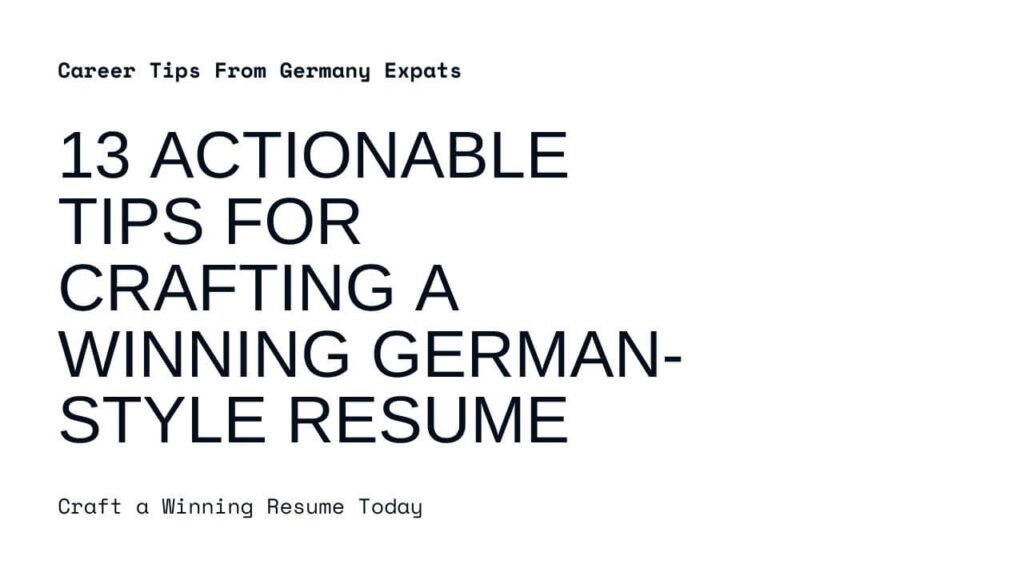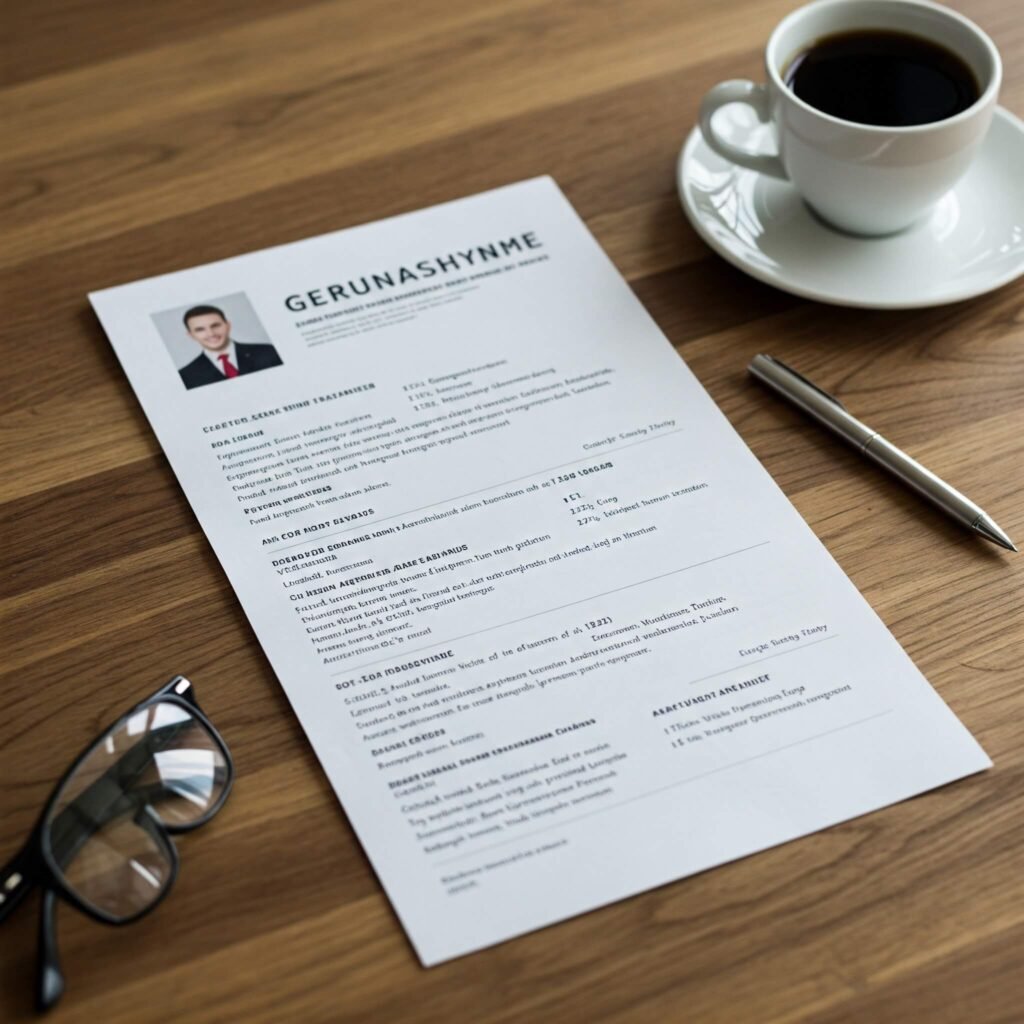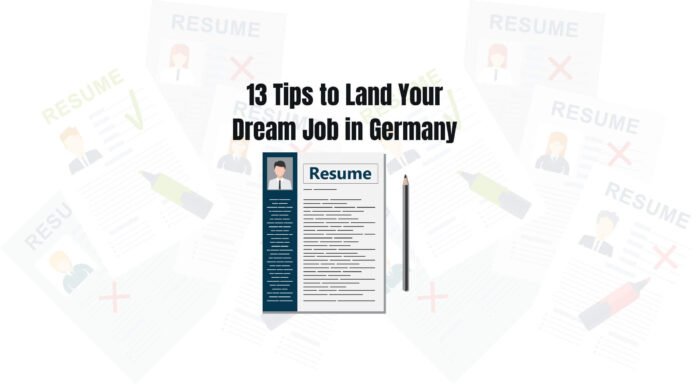German CV writing might seem tricky at first. But don’t worry—this guide will make it super simple. Let’s learn how to make a great German-style resume, or Lebenslauf, step by step. You can also explore our German CV Samples.
Introduction
Dreaming of a career in Germany? Your first step is mastering the German-style resume, a crucial tool for landing a job in Germany. Unlike resumes in many other countries, the German Lebenslauf follows a structured format that reflects precision and professionalism. A well-crafted resume can make or break your chances in a highly competitive job market.
Many international job seekers struggle to adapt their resumes to German standards. In countries like the U.S. or India, resumes often focus on personal achievements and creative layouts. In Germany, however, recruiters expect a straightforward, fact-based resume with a clear structure. Missing key details or following the wrong format can hurt your chances of getting interviews. Understanding these differences is essential for success.
This article will provide 13 actionable tips to help you craft a winning German-style resume. You’ll learn how to format your resume correctly, include essential sections, and highlight your skills in a way that appeals to German employers.
Germany is one of the most attractive destinations for skilled professionals. It draws talent worldwide with a strong economy, excellent work-life balance, and numerous job opportunities. Companies value experienced workers and offer competitive salaries, making Germany an ideal place to build a successful career. However, to secure a job, you need a resume that meets German standards—and that’s precisely what this guide will help you achieve.
Understanding the German Job Market & Resume Culture
Germany has one of the strongest economies in Europe, offering numerous job opportunities across various industries. Engineering, IT, healthcare, finance, and manufacturing are among the top sectors seeking skilled professionals. The country values technical expertise, formal qualifications, and work experience, making it crucial for job seekers to highlight these aspects in their applications. Unlike some other countries where networking plays a more prominent role, qualifications and structured applications carry significant weight in Germany.
Key Differences Between German and International Resumes
The German-style resume (Lebenslauf) follows a highly structured format that differs from resumes in many other countries. Here’s what makes it unique:
- Strict formal structure – A German resume is usually one to two pages long and follows a chronological or reverse-chronological order. It presents only factual information without exaggerated claims.
- Professional photo – Unlike in the U.S. or U.K., adding a high-quality headshot is typical and often expected. It should be a professional-looking, passport-style photo.
- Detailed personal information – German employers expect to see full name, date of birth, nationality, address, phone number, and email at the top of the resume.
- Certifications and references – German employers place high value on official certificates, diplomas, and reference letters. If you have relevant qualifications, include them in your application.
- No lengthy personal statements – Unlike in some countries where resumes start with a summary, the German Lebenslauf jumps straight into professional and educational history.
Understanding these differences is crucial to making a strong impression on German employers.
The Role of the Anschreiben (Cover Letter)
An Anschreiben (cover letter) is as essential as a resume in Germany. It is a formal introduction, explaining why you’re a good fit for the role and how your skills match the company’s needs. Unlike generic cover letters in other countries, German employers expect a customized and well-structured Anschreiben tailored to each job application.
13 Actionable Tips for Crafting a Winning German-Style Resume

Tip 1: Structure Your Resume with Precision (Lebenslauf Structure)
A well-structured Lebenslauf is essential in Germany. Employers expect a chronological format, typically in reverse order (starting with the most recent experience). Your resume should be clear, concise, and fact-based, avoiding unnecessary details or creative layouts.
A standard German resume includes these key sections:
- Personal Information – Name, contact details, and other required details.
- Work Experience – List jobs with company names, positions, and dates.
- Education – Include degrees, institutions, and years attended.
- Skills – Highlight relevant technical and soft skills.
- Additional Qualifications – Certifications, language proficiency, and training courses.
- Interests/Hobbies – Optional, but can help show personality and cultural fit.
A two-page limit is ideal unless you have extensive experience requiring additional space.
Tip 2: Include a Professional Photo
Unlike many countries, a photo on a resume is standard in Germany. However, not just any picture will do. Employers expect a high-quality, professional headshot that conveys competence and reliability.
Guidelines for a professional photo:
- Wear formal or business casual attire.
- Use a neutral background (white, grey, or light-colored).
- Ensure good lighting and avoid selfies or casual photos.
- Look approachable yet professional.
While a photo isn’t legally required, not including one can disadvantage you in many industries.
Tip 3: Provide Comprehensive Personal Information

A German Lebenslauf requires more personal details than resumes in other countries. Employers expect to see:
- Full Name
- Address (Street, City, Postal Code)
- Phone Number
- Email Address
- Date of Birth
- Nationality
Some job seekers also include marital status and number of children, though this is optional. These details help employers process applications efficiently and align them with company regulations, such as tax and insurance policies.
Tip 4: Detail Your Work Experience Thoroughly
Your work experience section is one of the most essential parts of your German-style resume. Employers expect a clear, structured listing of your professional history in reverse chronological order.
For each job, include:
- Company Name – Full official name.
- Job Title – Exact position held.
- Dates of Employment – Month/Year format (e.g., March 2020 – Present).
- Responsibilities – Key tasks and duties performed.
- Achievements – Highlight specific accomplishments and quantify results where possible.
Example:
Software Engineer | Siemens AG | January 2019 – Present
- Developed automation tools that reduced system downtime by 30%.
- Led a team of five developers to launch a new mobile application used by over 50,000 users.
- Improved cybersecurity measures, reducing data breaches by 40%.
Tip: German employers value data-driven achievements over generic job descriptions. Provide numbers, metrics, or tangible results to showcase your impact, if possible.
Tip 5: Emphasize Relevant Educational Qualifications
German employers take formal education seriously. Your educational background should be presented clearly and concisely, focusing on degrees and qualifications relevant to the job.
For each qualification, include:
- University Name – Full name of the institution.
- Degree Earned – Specify Bachelor’s, Master’s, or PhD.
- Major/Field of Study – Clearly mention your specialization.
- Graduation Date – Year (and month if recent).
- Relevant Coursework & Thesis (Optional) – If applicable, mention courses or research topics related to the job.
Example:
M.Sc. in Mechanical Engineering | Technical University of Munich | 2021
- Thesis: “Sustainable Energy Solutions in Automotive Engineering”
- Relevant coursework: Fluid Dynamics, Automotive Design, Renewable Energy Systems
Tip: Germany has a qualification-driven job market. Employers often verify degree authenticity and prefer candidates with degrees aligned with the job requirements.
Tip 6: Highlight Your Skills and Competencies
A well-crafted skills section helps recruiters assess your technical, language, and soft skills quickly. Keep this section concise but impactful by listing skills relevant to the role.
Types of skills to include:
- Technical Skills: Programming languages, software expertise, engineering tools, industry-specific skills.
- Language Skills: German proficiency is a significant advantage if applying in Germany. Use CEFR levels (A1 to C2) to indicate fluency.
- Soft Skills: Leadership, teamwork, problem-solving—mention these only if they directly relate to the job.
Example:
- Programming Languages: Python, Java, SQL
- Software Tools: AutoCAD, SAP ERP, Microsoft Power BI
- Languages: German (B2), English (Fluent), French (A2)
- Project Management: Agile, Scrum
Tip: German employers appreciate specific, measurable skills rather than vague statements. Clearly categorize your skills and, where possible, certify your competencies (e.g., a B2 certificate in German).
Tip 7: Showcase Additional Qualifications and Certifications

German employers value continuous learning and professional development. Listing relevant certifications, training courses, and workshops can set you apart from other candidates.
Include:
- Professional Certifications – Industry-recognized credentials (e.g., PMP, AWS Certified Solutions Architect, CFA).
- Training Courses – Short courses related to your field (e.g., Data Analytics, Digital Marketing, Machine Learning).
- Workshops & Seminars – Especially those recognized internationally or within the German job market.
Example:
- Certified Scrum Master (CSM) | Scrum Alliance | 2022
- Data Science & Machine Learning | Coursera | 2021
- SAP ERP Training | Siemens AG | 2020
Tip: German companies appreciate employees who invest in professional growth. A well-known certification increases your credibility and strengthens your resume.
Tip 8: Mention Relevant Interests and Hobbies
While optional, listing hobbies and interests can make your resume more engaging, showing your personality and cultural fit. However, this section should be brief and only include relevant activities.
Recommended hobbies:
- Volunteering & Community Work – Shows responsibility and teamwork.
- Sports & Fitness – Demonstrates discipline and team spirit.
- Blogging & Writing – Highlights communication skills.
- Foreign Languages – Useful for international workplaces.
- Music & Arts – Shows creativity and dedication.
Hobbies to avoid:
- Political or controversial activities.
- Generic interests like “Watching TV” or “Socializing”.
- Anything too personal, like religious practices.
Example:
- Volunteering: I mentor at a coding boot camp.
- Sports: Member of a local football club.
- Languages: Learning Spanish (A2 level).
Tip: Recruiters look for well-rounded candidates who fit into the company culture. Listing structured hobbies can spark conversation during interviews and make you more memorable.
Tip 9: Use Formal and Professional Language
A German-style resume must be formal, precise, and error-free. German recruiters dislike informal language, slang, or unnecessary embellishments.
Best Practices:
- Use neutral, professional language (no excessive self-praise).
- Keep sentences short and to the point.
- Avoid overly creative or vague descriptions—stick to facts.
- Use industry-specific terminology where appropriate.
Common Mistakes to Avoid:
- Using casual phrases like “I smashed my sales targets!”
- Overusing buzzwords without proof (e.g., “visionary leader” or “game-changer”).
- Grammar or spelling errors—proofread carefully!
Tip: A resume with typos or casual language signals unprofessionalism. German employers expect structured, fact-driven communication, so always double-check spelling, grammar, and clarity before submitting your application.
Tip 10: Tailor Your Resume to Each Job Application
A one-size-fits-all resume won’t work in Germany. Employers expect customized applications highlighting skills and experiences relevant to the job description.
How to tailor your resume effectively:
- Analyze the job description – Identify key skills and requirements.
- Match your experience – Emphasize relevant achievements that align with the role.
- Research the company – Understand its culture and values to reflect a good fit.
- Use industry-specific keywords – Many companies use Applicant Tracking Systems (ATS), so incorporating relevant keywords improves your chances of passing the screening.
Example: If applying for a Software Engineer role at a German company using SAP, highlight your experience with SAP systems, German workplace methodologies, and Agile development.
Pro Tip: German employers value precision. A tailored resume shows effort, increases relevance, and improves your interview chances.
Tip 11: Use a Consistent and Professional Format

Your resume’s design and readability matter as much as its content. German recruiters expect a clean, structured layout that makes it easy to scan quickly.
Formatting guidelines:
- Use simple, professional fonts like Arial, Calibri, or Times New Roman (size 11-12).
- Maintain consistent formatting for headings, bullet points, and text alignment.
- Stick to black text on a white background—no colors or fancy designs.
- Use clear section headings to structure information logically.
- Ensure proper spacing for readability (1.15–1.5 line spacing).
Avoid:
- Excessive use of bold, italics, or underlining.
- Decorative fonts or complex layouts.
- Overuse of graphics, tables, or visual elements that may confuse ATS systems.
Pro Tip: A professionally formatted resume looks polished and makes a strong first impression. Many recruiters scan resumes in less than 30 seconds, so clarity is crucial.
Tip 12: Include References (if requested)
Unlike some countries where references are standard, German employers only request references when necessary. If a job posting asks for them, be prepared to provide reliable contacts.
Best practices for references:
- Include two to three professional references (former managers, supervisors, or colleagues).
- List their full name, job title, company, phone number, and email.
- Inform your references beforehand so they’re prepared to speak positively about you.
- If references aren’t requested, simply state, “References available upon request.”
Example:
Dr. Michael Schmidt
Senior Project Manager, Siemens AG
Email: michael.schmidt@siemens.com
Phone: +49 170 1234567
Pro Tip: Strong references validate your work experience. German employers often check references before making a final hiring decision, so ensure your listed contacts can provide credible recommendations.
Tip 13: Get Your Resume Reviewed by a Native Speaker
Before submitting your German-style resume, you must check for language accuracy and cultural appropriateness. Even small grammar mistakes or awkward phrasing can create a negative impression.
How to ensure quality:
- Have a native German speaker review your resume.
- Use professional proofreading services if you’re unsure about grammar.
- If applying in English, ensure your resume meets German employer expectations.
- Avoid using Google Translate—it can lead to unnatural wording.
Pro Tip: A polished, error-free resume signals attention to detail and professionalism. German employers value accuracy and precision, so a well-reviewed resume boosts your credibility and chances of getting hired.
Optimizing Your Online Presence (Beyond the Resume)

A well-structured German-style resume is crucial, but employers also review your online presence before making hiring decisions. Enhancing your LinkedIn profile, networking effectively, and improving your German language skills can significantly enhance your job prospects.
LinkedIn Profile Optimization
In Germany, recruiters and hiring managers widely use LinkedIn and XING. Your LinkedIn profile should mirror your resume while offering additional insights into your skills, achievements, and professional interests.
Key steps for an optimized LinkedIn profile:
- Use a professional photo (similar to the one on your resume).
- Write a clear, keyword-rich headline (e.g., Software Engineer | SAP & AI Specialist).
- Ensure your work experience and education match your resume.
- Craft a compelling summary that highlights your expertise and career goals.
- Add relevant skills and get endorsements from colleagues.
- Request recommendations from former employers or coworkers.
- Connect with professionals in your target industry and engage with industry-related content.
Why this matters: Recruiters often cross-check resumes with LinkedIn profiles. A strong, up-to-date LinkedIn presence can help increase visibility and attract job opportunities in Germany.
Networking Strategies
Networking is a powerful tool for landing a job in Germany. Many vacancies are filled through professional connections before they’re publicly advertised.
Effective networking strategies:
- Attend industry events and job fairs—Look for career expos, trade fairs, and networking meetups in your field.
- Join professional associations – Many German industries have dedicated business groups and associations that offer networking opportunities.
- Engage in online communities – Participate in LinkedIn groups, XING forums, and industry-specific online platforms.
- Use informational interviews – Reach out to professionals in your target companies to learn about job opportunities and company culture.
Why this matters: A strong professional network can open doors to job opportunities that may not be listed on job portals. In Germany, referrals and recommendations carry significant weight.
German Language Proficiency
Even if you apply for an English-speaking role, German language skills give you a significant advantage in the job market. Many companies prefer candidates who can communicate at least at a B1 or B2 level.
While some jobs don’t require German fluency, knowing German significantly increases your chances of getting hired and advancing your career. Many employers prefer candidates who can adapt to Germany’s professional and social environment.
Official Sources for Jobs in Germany
The official link for jobs in Germany would depend on the type of job or sector you’re targeting. However, some widely recognized official and government-backed platforms for finding jobs in Germany include:
1. Federal Employment Agency (Bundesagentur für Arbeit)
Germany’s official employment agency offers a wide range of job listings and resources.
2. Make It in Germany
https://www.make-it-in-germany.com
An official government website for skilled workers seeking jobs and immigration opportunities in Germany. These platforms are reliable and government-approved and often provide additional resources like visa and relocation information.

Conclusion: Take the Next Step Toward Your Dream Job in Germany
Recap of Key Tips
Landing a job in Germany starts with mastering the German-style resume. To summarize:
- Structure your resume professionally – Use a clear, fact-based layout with essential sections.
- Include a professional photo – A high-quality headshot increases credibility.
- Provide detailed personal and work information – German resumes focus on precision and completeness.
- Highlight skills, education, and certifications. Show qualifications that match job requirements.
- Tailor your resume for each job application – Use relevant keywords to pass ATS screening.
- Maintain a strong online presence – Optimize your LinkedIn profile and expand your network.
- Improve your German language skills – Even basic proficiency boosts job opportunities.
By following these 13 actionable tips, you will significantly increase your chances of securing interviews in Germany.
Final Thoughts
Germany offers incredible career opportunities for skilled professionals, but success requires preparation and adaptability. By following these resume tips, customizing your applications, and enhancing your professional and language skills, you’ll be well on your way to landing your dream job in Germany.
FAQs
1. Can I send my resume in English?
Yes, but it’s better to use German unless the job ad says English is okay.
2. What size should my resume photo be?
A professional headshot, about 4×5 cm, works best.
3. Do I need to add references?
You don’t have to, but including them can help.
4. Is it okay to use colors?
Yes, but keep it simple and professional.
5. How much work experience should I include?
Focus on the last 10-15 years or your most relevant jobs.

